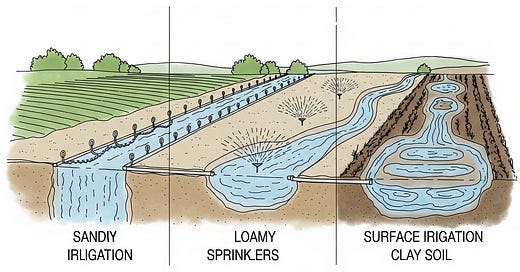Choosing the Right Irrigation System for Your Soil Type
Tailoring Water Delivery for Optimal Crop Growth and Water Efficiency
Understanding your soil type is one of the most critical steps in effective farm management, especially when it comes to irrigation. Different soils behave uniquely when water is applied, impacting how much water they can hold, how quickly it drains, and how it spreads. Matching your irrigation system to your soil's characteristics ensures every drop counts, leading to healthier crops and significant water savings.
Why Soil Type Matters for Irrigation:
Soil texture refers to the proportion of sand, silt, and clay particles in your soil. These particles' size and arrangement determine the soil's water holding capacity (how much water it can store) and its infiltration rate (how quickly water moves into and through it).
Sandy Soils: These soils have large particles and large pore spaces, allowing water to drain very quickly (high infiltration rate) but holding very little water. They dry out rapidly.
Clay Soils: Composed of very fine particles, clay soils have small pore spaces. Water infiltrates slowly, but once wet, they can hold a large amount of water, making them prone to waterlogging if over-irrigated.
Loamy Soils: A balanced mix of sand, silt, and clay, loamy soils generally offer good drainage and good water-holding capacity, making them ideal for most crops.
Silty Soils: These soils have medium-sized particles, offering a good balance between drainage and water retention, often feeling smooth and powdery.
Choosing the Right Irrigation System for Your Soil Type:
For Sandy Soils:
Challenge: Low water-holding capacity and high infiltration rate mean water drains quickly. Plants need frequent, light applications.
Best Systems:
Drip Irrigation (or Subsurface Drip Irrigation - SDI): Delivers water directly to the root zone slowly and frequently, minimizing deep percolation and evaporation losses. This is highly efficient for sandy soils.
Sprinkler Irrigation: Can be used, but requires frequent, short cycles to match the soil's rapid infiltration rate and prevent water from leaching past the root zone. Low precipitation rate sprinklers are ideal.
For Clay Soils:
Challenge: Slow infiltration rate and high water-holding capacity. Applying water too quickly causes runoff and potential erosion. Over-watering leads to waterlogging and root rot.
Best Systems:
Drip Irrigation: Excellent choice. It applies water very slowly and precisely, allowing clay soil to absorb it without runoff. This method also helps reduce surface evaporation and fungal diseases often associated with wet surface conditions on clay soils.
Low Precipitation Rate Sprinklers (e.g., Rotary Heads): If sprinklers are used, select those with very low application rates that match the soil's slow infiltration. This prevents runoff and allows the water to soak in gradually.
Surface Irrigation (Basin or Furrow): Can be effective on flat clay soils due to their slow infiltration and good lateral spread, but requires careful management to avoid over-irrigation and waterlogging.
For Loamy and Silty Soils:
Challenge: These soils offer a good balance, but still require careful management to optimize water use.
Best Systems:
Sprinkler Irrigation: Often a very good choice as these soils can absorb water at a moderate rate, allowing for even distribution. Various types, including center pivots, linear moves, and solid-set sprinklers, can work well.
Drip Irrigation: Also highly effective, offering excellent water efficiency and precise nutrient delivery (fertigation). It's particularly beneficial for high-value crops or in areas with water scarcity.
Surface Irrigation: Can be used, especially in flatter areas, but may require more land preparation and monitoring than pressurized systems to ensure even distribution.
Key Considerations Beyond Soil Type:
While soil type is paramount, remember to also consider:
Crop Type: Different crops have different water needs and root depths.
Climate: Wind, temperature, and humidity affect evaporation and system choice.
Topography: Slopes can influence runoff and system suitability.
Water Availability and Quality: The source and quality of your water can impact system longevity and efficiency.
Budget and Labor: Initial installation and ongoing operational costs vary significantly between systems.
Conclusion: Optimizing Your Farm's Potential Through Smart Irrigation
At Farmer's Chat, we believe that understanding your soil is the first step towards a thriving and sustainable farm. Choosing the right irrigation system based on your soil type is not just a technical decision; it's a strategic move to maximize water efficiency, boost crop yields, and reduce operational costs. As a non-profit initiative, we are dedicated to empowering farmers, the true backbone of civilization, with the knowledge and tools needed to make informed decisions and foster sustainable agricultural practices.
Invest time in understanding your soil. It's the foundation of your success. Explore our learning resources for detailed guides on soil testing and irrigation system setup. Connect with us on social media to share your experiences and learn from a community passionate about growing smarter, not harder. Your engagement helps us continue our vital mission for the betterment of agriculture and the planet.
#IrrigationSystems #SoilType #PrecisionIrrigation #WaterManagement #SustainableAgriculture #FarmEfficiency #CropYields #SoilHealth #FarmersChat #Farmers #Agriculture #VishalRajput




